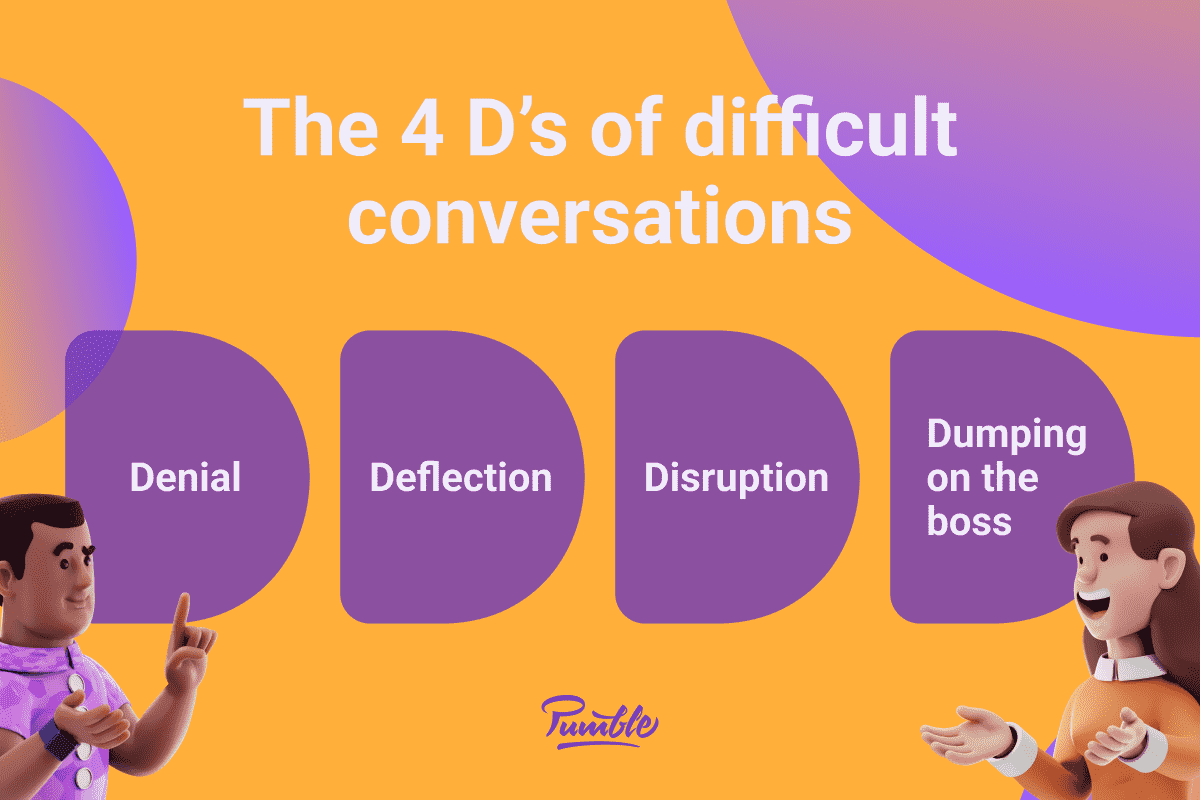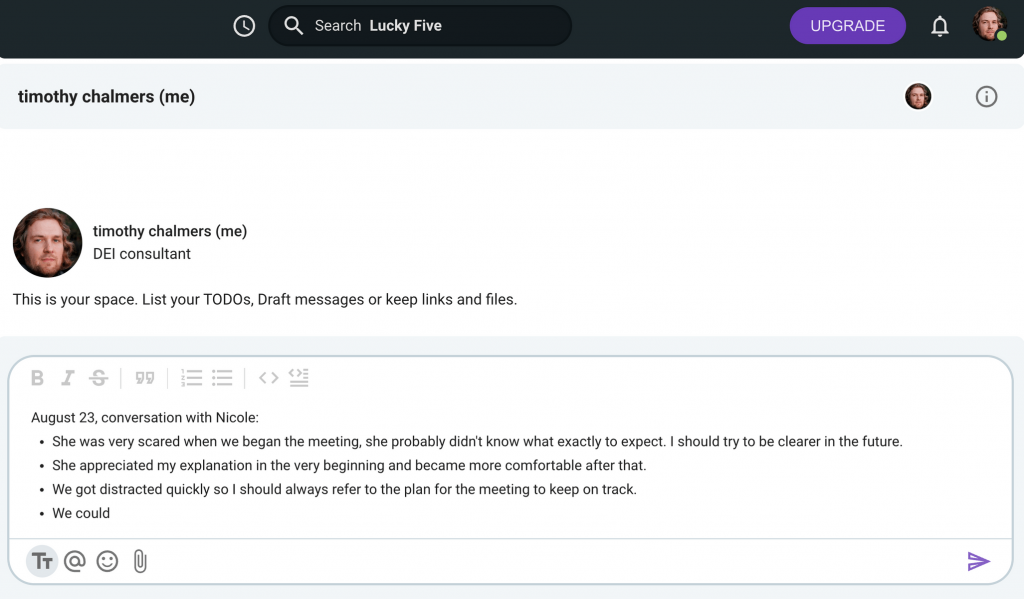Navigating difficult conversations in the workplace is part of any leader’s job.
And while it’s probably uncomfortable for both you and your employee — it’s also what has to be done sometimes.
These conversations are often challenging. But, with proper training and preparation, they can turn into a powerful tool for achieving long-term business goals.
In this blog post, we’ll dive deeper into the concept of a difficult conversation and go through some examples of difficult conversations in a workplace setting.
We’ll also discuss the steps for structuring difficult conversations better and list the potential consequences of avoiding them.
Finally, we’ll outline some useful tips for engaging effectively in difficult conversations.
Shall we dive in?

Table of Contents
What is a difficult conversation with an employee, according to experts?
To help the readers better understand what a difficult conversation might entail, I’ve reached out to a few leadership experts and psychologists and picked their brains on the topic.
Here’s what they said.
Difficult conversations are hard for both the employee and the manager
Difficult conversations are often difficult for both the employee and the manager leading the conversation.
That’s what Bill Catlette, an executive coach and partner at Contented Cow Partners said when I reached out to him to discuss the concept of a difficult conversation.
He explained that several factors can make a conversation difficult:

“The difficulty associated with some bit of negative news is often enhanced by the fact that it is being delivered later than it should, by surprise, and by an individual who is ill-prepared to do so.”
Difficult conversations can be a step into the unknown
According to Sandra O’Shea, a Chartered MCIPD and HR & OD Consultant at SOS HR Consultancy & Coaching, difficult conversations can be uncharted territory for managers:

“A difficult conversation is where the main topic is likely to be sensitive, possibly contentious, and may potentially result in serious consequences. It can be a step into the unknown, even when you carefully prepare for the conversation, as you don’t know how the other person might react.”
However, she also believes these talks are an integral part of being a leader:

“It means that there is an issue that is having an impact and that needs to be explored, discussed, and addressed with the employee as a way of facilitating forward movement. It also means that you are leaning into your responsibilities as a leader/line manager and taking proactive actions for an open, honest, and supportive working environment.”
Difficult conversations are defined by the negative feelings they might evoke
In line with Catlette’s remarks, William Ratliff, a Senior Career Services Manager at Employment BOOST, says the following about difficult conversations:

“Generally, there’s a sense that the topic of the conversation may hurt one or more parties. In a professional setting, this can be a discussion about poor performance, personal issues that have affected productivity, or HR issues.”
Moreover, Ratliff explains why every difficult conversation is a challenging one, too:

“Whether in the workplace or at home, what makes difficult conversations challenging is that they have to happen and they are likely to sting.”
Difficult conversations are a step outside your comfort zone
Ultimately, for Lorena Pérez, Chief People Officer at Novakid, having a difficult conversation represents a step outside of our comfort zones:

“Having a difficult conversation is when the topic or the news we need to share is not going to be easy to discuss and we move out of our comfort zone.”
Stepping outside one’s comfort zone isn’t an easy task.
So, to help managers prepare better to navigate a difficult conversation, we’ll now move on to account for its elements.
What are the elements of a difficult conversation?
In their book, Difficult Conversations: How to Discuss What Matters Most, Bruce Patton, Douglas Stone, and Sheila Heen wrote that there are three deeper conversations that underline every difficult conversation:
- The “What happened?” conversation — The parties disagree on what happened, what should happen, and who is to blame.
- The feelings conversation — The parties acknowledge, discuss, and validate their emotions.
- The identity conversation — Each party analyzes the situation and thinks about what it could tell about them, in an attempt to protect their sense of self.
According to the authors, the key to having meaningful conversations is to recognize these deeper conversations and try to turn them into opportunities for learning and growth.
In addition to this, we can also identify 4 common elements of difficult conversations:
- Differing perceptions,
- Assumptions about intent,
- Feelings, and
- Blame.
Let’s examine each element a bit further.
💡 Pumble Pro Tip
In addition to having to handle difficult conversations at work, sometimes you’ll have to deal with difficult people, too. Learn how to do it effectively:
Element #1: Differing perceptions
If two parties are involved in a difficult conversation, they will probably have two different perceptions of the same problem or situation.
In plain English — both sides probably think they’re right and neither sees themselves as the problem.
This usually happens because we have:
- Different information about the same event/decision/problem.
- Different interpretations of the same event/decision/problem.
A difficult conversation can be even more difficult to handle if neither side is willing to compromise to find a common ground or reach a common goal.
Element #2: Assumptions about intent
When we find ourselves trapped in a difficult conversation, we often assume we know the other person’s intentions. However, that’s far from the truth.
What we tend to overlook is that intentions are a concept that exists only in someone’s mind or heart — and unless they share them with us, we can’t know what they are for sure.
For example, if we feel hurt by the other person, we automatically assume they intended to hurt us.
But, what actually happened here?
We’ve concluded that the person wanted to hurt us based on our assumptions of what their intentions might be.
We haven’t openly asked them what their intentions were.
So, we may have assumed the wrong thing.
Element #3: Feelings
Oftentimes, we engage in situations emotionally — which can affect our ability to think straight, solve problems, and communicate effectively.
When we’re upset or impatient, our thinking and listening skills are clouded by negative emotions — and we find it hard to actively listen to what the other person is saying and see things from their perspective.
Approaching a situation emotionally charged can:
- Make it harder to navigate the difficult conversation in the right direction, and
- Minimize the chances of a pleasant outcome.
💡 Pumble Pro Tip
When we communicate with others and want to evoke a certain response from the other person, we can use emotive language. Learn more about what emotive language is and how you can use it properly in a workplace setting.
Element #4: Blame
Blaming others is one of the many defense mechanisms humans recur to in conflicting situations. Those who rely on blame in difficult conversations are usually guided by questions such as:
- Who made a mistake?
- Who should apologize first?
- Who is being stubborn and resentful?
But when we’re blaming the other person, we find it harder to:
- Be non-judgemental,
- Find the real cause of the problem, and
- Take concrete steps to fix the problem in question.
Knowing the elements of difficult conversations is of utmost importance for all of you who are trying to be good communicators.
However, that’s not all.
You should also be familiar with the 4 D’s of difficult conversations. Let’s explore them, too.
What are the 4 D’s of difficult conversations?
More often than not, managers and team leads aren’t trained (enough) to handle difficult conversations with their employees.
In one Poynter article, the head of the leadership and management faculty of the Poynter Institute, Jill Geisler, wrote about the 4 D’s that can derail a difficult conversation.
These are:
- Denial,
- Deflection,
- Disruption, and
- Dumping on the boss.

Here’s how they can derail an already difficult conversation and what you can do to deal with each D of your difficult conversation.
D #1: Denial
The other person might reject the message you’re trying to convey. They might also claim that what you’re saying isn’t true and then completely shut down.
🔸 Tips for dealing with denial
To be able to better deal with denial, you should aim for specific and thorough preparation. Remember what your goals are:
- To address a certain situation and go through the facts, and
- To learn about the person’s next steps.
D #2: Deflection
The other person might recur to changing the subject very quickly in an attempt to divert you from carrying out the conversation until the end.
🔸 Tips for dealing with deflection
It’s important that you don’t let them steer the conversation in the direction they want to. You should stay focused on:
- Why you are having this conversation, and
- What your goals are.
D #3: Disruption
The other person might try to disrupt the conversation by:
- Shouting,
- Swearing,
- Sobbing,
- Storming out, or
- All of the above.
🔸 Tips for dealing with disruption
When dealing with disruption, it’s essential that you:
- Keep your cool,
- Avoid the temptation to respond in the same way as the person you’re talking to,
- Stay rational and calm.
- Prepare in advance for handling people who cry (think tissues and compassion).
D #4: Dumping on the boss
The other person might try to criticize you and put the blame on you or the organization.
🔸 Tips for dealing with dumping on the boss
If you ever experience this, you should remember that this is just another defense mechanism. People tend to blame others when they think they are being criticized or attacked.
Instead of jumping in on their train, try to distance yourself from the emotions and focus on steering the conversation back in the initial direction.
—
Now that we’ve outlined the important elements of difficult conversations and examined the four D’s that can make them even more difficult, it’s time to take a look at some examples and learn why we sometimes have to engage in difficult conversations with our employees.
Difficult conversations with an employee: Examples
According to Catlette, the manager can have a wide range of reasons to engage in a difficult conversation with an employee:

“I need you to change jobs, to work late today, to work alongside someone you don’t like, your work performance is unsatisfactory, you did not get the promotion you were seeking, or, gulp, today is your last day here.”
O’Shea admits that she’s had her share of difficult conversations around a wide range of issues, too. These include:
- Inappropriate behavior,
- Performance,
- Attendance,
- Presenteeism,
- Annual leave requests being turned down,
- Pay and reward,
- Health (including alcohol and drug dependency),
- Work-related stress,
- Promotion (including non-selection for promotion),
- Job evaluation,
- Redundancies,
- Bullying and harassment,
- Upward conversations with the Board about organizational culture and leadership, and
- Conversations with her own line manager about her boundaries and workloads.
—
The reasons for having a difficult conversation can be different and there are many of them.
But what if you decide to not have a difficult conversation with your worker?
Are you aware of the consequences that avoiding difficult conversations can produce?
Let’s see how detrimental this can be for you and your employees.
Consequences of avoiding difficult conversations with employees
Avoiding hard conversations with employees can have undesirable, long-term consequences.
Here’s what our contributors think about this.
Avoiding difficult conversations is unfair to employees
From O’Shea’s point of view, avoiding a hard discussion isn’t fair and can be interpreted as sweeping problems under the carpet:

“Avoiding having a difficult conversation is unfair to all those impacted by the issue and misleading to the employee who may think that there isn’t a problem.
In cases of inappropriate behavior, it may be completely misinterpreted as being OK if left unchallenged. If left, the issue will likely get worse and can impact team morale, interpersonal relationships, well-being, productivity, company reputation, and culture.
Although these conversations are difficult, procrastination is not the answer. In my view, it is important to work toward a psychologically safe workplace and healthy culture.”
In harmony with O’Shea, Pérez adds:

“When expectations are not aligned, it causes frustration and friction, which impacts employees’ work output, performance, and collaboration with others.”
In addition to the consequences outlined above, avoiding tough conversations can also result in:
- Higher turnover rates,
- Increased revenue loss,
- Hindering an employee’s professional development and growth, and
- Disrupting trust between you and your employees.
Avoiding difficult conversations isn’t what true leaders do
Knowing what can happen if you avoid going through tough conversations can be extremely helpful.
Yet, Catlette believes that strong leaders are defined by their courage to go through a difficult conversation until the end:

“Senior leaders must take into account the fact that having conversations of this sort is a regular and necessary part of any leader’s job, by virtue of which, having the requisite courage to do so is a vital qualification for anyone being considered for a leadership role.
I would go further and suggest that, while things like communication, presentation skills, or executive presence can be taught, courage cannot. It’s ‘factory-installed.’”
In addition to having the courage to go through a serious and unpleasant conversation, you should also know how to structure your conversations to make sure you carry them out successfully.
Let’s go over the steps you should implement to conduct a difficult conversation effectively.
Steps for structuring a difficult conversation with an employee
Before you engage in a conversation with your employee, you should know how to structure it properly.
According to O’Shea, “preparing for the conversation and thinking about how you might structure it is a key component.”
Here are the steps that she usually takes as part of her preparation for such a meeting/conversation:

“How will I define the issue and how does it manifest in the workplace (giving examples where appropriate)?
What policies does the company have in place that I or the employee might need to refer to?
What am I feeling about this? — Checking in with my own emotions, assumptions, values, and beliefs making sure they are not getting in the way.
Creating a space that allows me to share what the issue is from my perspective and then hold space while the employee digests the information and responds to it — taking great care to handle their reactions carefully.
Listening carefully to the employee’s response and avoiding getting drawn into differences of opinions — remaining focused on the issue and not personalizing it.
Staying alert for the ‘nuggets’ that will aid forward movement.
Remaining authentic, compassionate, and professionally appropriate.
Depending on the issue, there may be some actions that can be agreed upon and supported. However, occasionally there may be more serious consequences that follow — like dismissal, suspension, risk of redundancy, or formal proceedings.”
As you can see, there’s a lot to account for before engaging in a difficult discussion with an employee.
In addition to this, Catlette shared what he believes would help individuals leading such conversations generally have a better time of it:

“Be thoughtful as to the time and place of the conversation.
Do it privately and in person whenever possible.
Envision how the employee might perceive or react to the conversation.
Give the individual as much consideration/respect as possible.
Steel yourselves sufficiently to look another person (perhaps a person they think highly of) in the eye and deliver bad news.“
Difficult Conversation Preparation Worksheet Template

Sometimes, it can be hard to make yourself engage in a difficult conversation, especially if you don’t know where to begin or how to structure it properly.
To help you with that, we’ve created a DIfficult Conversation Preparation Worksheet Template. It outlines all the important steps for structuring a difficult conversation and helps you focus on all the important details to carry it out effectively.
Download the Difficult Conversation Preparation Worksheet Template
We’ve come to the final part of this difficult conversation guide — tips for making them more effective and less anxiety-inducing.
Tips for effectively engaging in difficult conversations with employees
Difficult conversations are in essence one form of performance reviews and feedback.
And, just like with feedback, thorough preparation is one of the safest ways to carry out difficult conversations the way you imagined and reduce the stress that comes with it.
Check out these 13 tips to prepare better.
Tip #1: Create a safe and understanding environment
As far as Sam Browne, the CEO of HARO SEO, is concerned, difficult discussions are an integral part of working successfully with others.
He believes they should be based on understanding:

“Understanding is frequently the first step in establishing a more positive working atmosphere and handling difficult conversations better. First and foremost, I think it’s important to strive toward comprehension first. Many solutions are built on understanding, therefore both parties in the dialog should be under the same roof.”
Moreover, O’Shea believes that investing time in arranging the discussion properly can help the employee prepare better for it, too:

“Think about how you will arrange to meet with the employee – an ominous and vague email or calendar invite can be stressful with the potential for the employee to attend on high alert and defensive.”
When you approach the conversation with understanding, you’re creating a psychologically safe and intimate environment for you and your employee to have a serious and confidential conversation.
Tip #2: Make a plan for each difficult conversation
Having a plan for every tough discussion is like having a compass when you go hiking.
Picture this scenario:
In the middle of the conversation, the employee starts shouting uncontrollably and you don’t know what to do.
You haven’t prepared in advance and don’t know how to help them calm down and make it to the conversation finish line.
So, you decide to postpone the entire thing, further prolonging the tough conversation.
If you come prepared, you can do the following:
When the employee starts yelling, you’ll know that they are trying to disrupt the conversation (The four D’s of difficult conversations).
Once you recognize that, you’ll know that you should stay calm and avoid mimicking their communication style. You’ll also know that shouting is only one stage of disruption and can prepare mentally for others, too.
O’Shea recommends:

“Do your preparation — so that you know how you will structure the conversation. It helps if you need to get back on track.”
Browne supports planning ahead, too:

“Planning in advance allows you to focus on having a constructive conversation rather than trying to find a solution to have a healthy conversation.”
In addition to knowing how to act during the conversation, you should also:
- Gather relevant information about the problem in question.
- Revise important company policies.
You want to have all the answers.
Tip #3: Schedule an appropriate time for the conversation
Instead of relying on email to schedule a meeting with your employee, you can try to set up a meeting with the help of your employee communication app.
In remote work settings, most employees communicate through team chat apps — and that’s what makes it easier to minimize the formality surrounding these difficult conversations.
So, you can discuss the best time for the 1:1 meeting with your employee via your chat app and then schedule it in your calendars. Designating time to have this conversation in private will show how much you respect and care for your employee.

💡 Pumble Pro Tip
Thanks to modern online collaboration apps, such as Pumble, you can streamline your business communication easily. Check out how:
Tip #4: Approach the conversation with empathy
For a difficult conversation to be effective, leaders should always approach these conversations from a place of empathy.
The CEO of Go Cloud Careers, Michael Gibbs feels it’s critical that we showcase empathy in any difficult conversation scenario.
He says:

“The goal of the conversation is to remedy the problematic situation without damaging the relationship. Gather facts, collect evidence, and make sure there are no extraneous circumstances causing the problem.
I suggest letting the conversation play out in your mind with different scenarios prior to the actual conversation. In this manner, you have the greatest chances of having the desired outcome.”
Pérez also advises:

“Listen and be emphatic. Understand the other party by putting yourself in their shoes.”
Browne believes an empathic approach is what helps foster transparent communication and reduces the chances for conflict:

“The executives should always come from a place of empathy. They should also radiate a humble ambiance because otherwise, it will create a condescending environment wherein employees are afraid to speak up. Lastly, they should refrain from being self-serving. The goal is to achieve healthy, responsive communication that solves a conflict.”
Moreover, Ratliff thinks that choosing your words wisely is important for showcasing empathy, too. In a difficult conversation, you want the employee to know that you’re aiming for conflict resolution and not for criticism or shaming.
He suggests:

“Even if the difficult conversation is a result of an employee’s behavior, it’s still essential to empathize with the person and consider how they’ll feel before you have the discussion. Reflect on how they might react to certain phrasing or language, and use words that convey care and concern instead of anger or frustration.”
Ultimately, an empathic communication style is more likely to provide positive outcomes and make the entire experience less stressful for both you and the employee.
Tip #5: Fine-tune your communication skills
About 69% of managers feel uncomfortable when communicating with their employees face-to-face.
However, the modern business world is built on effective communication. In some cases, company success can be measured by the way its executives and managers communicate with their employees and other parties.
Leaders can find it even harder to communicate and convey their message clearly in tough discussions, yet that shouldn’t stop them from practicing and becoming more effective at it, Gibbs believes:

“Leaders can be much more effective in handling difficult conversations with training and practice. Being empathetic, emotionally intelligent, and open-minded can really help in managing a difficult conversation. Asking open-ended questions in a non-judgmental fashion along with active listening also improves the outcomes of difficult conversations.”
Setting an example for communication is a great way to make sure the conversation goes in the desired direction. So, instead of dwelling on why or how to do this, try to focus on rehearsing the conversation in advance and flexing your communication style based on the needs of the employee and the conversation.
💡 Pumble Pro Tip
Check out our blog post if you need actionable advice for improving your leadership communication skills:
Tip #6: Listen actively to what your employee has to say
Difficult conversations are never easy — but if you are to handle them better, you should learn to listen before you speak.
More often than not, communication is about active listening and not speaking.
Ratliff also finds active listening more important than speaking:

“Difficult conversations are always a challenge — after all, we wouldn’t call them ‘difficult’ if we enjoyed them! To handle them better, remember that listening is more important than speaking, and that includes listening to words and body language.”
Even in remote or distributed work environments, you should always acknowledge what your employees are saying and their body language — it will boost their engagement and morale, too.
After all, finding a common ground with your employee depends a lot on your ability to see things from their perspective and their ability to see things from yours.
Tip #7: Challenge behaviors and actions, not personalities
Quite often, it’s something that the employee did that led to a difficult conversation and not their personality traits.
That’s why O’Shea believes leaders should “keep the issue in focus rather than the person.”
Ratliff is of a similar opinion:

“Don’t blame the person, and never suggest that the issue is something about the person’s personality.
For example, don’t say ‘Jeff, your tardiness is creating serious issues for the department,’ and instead say ‘Jeff, on the days when you’re tardy, it creates some serious issues for the department.’
While subtle, the distinction tells the person that it’s their action, not their personality, that is the root of the issue.
Humans can fix actions, not personality traits, and the goal of the conversation is to inspire change, not instigate shame.”
Tip #8: Don’t make assumptions before hearing their side of the story
Both Pérez and Ratliff agree that jumping to conclusions isn’t the best way to go when navigating difficult discussions with employees.
Pérez says that letting the other person speak and discussing matters openly when given the chance is better than keeping things for yourself:

“Allow the person time to speak. Don’t respond too quickly or jump to conclusions or judgments. Be honest and transparent with your feelings so that your side of the issue can be easily understood by the other person. Don’t keep things bottled up when the chance to discuss things arises.”
Furthermore, Ratliff believes that the leaders are responsible for not assuming anything and showing genuine interest in their employee’s story:

“As a leader, the burden is on you to control your emotions and engage the person in a way that shows you value and care about them. This is critical, especially if you’re discussing something that they might be embarrassed or ashamed of.
While the nature of the issue might affect the language you ultimately decide to use, always approach the conversation with respect, patience, and empathy. Don’t make any assumptions — especially nefarious ones — until you’ve heard their side of the story.”
Tip #9: Try to understand why a difficult conversation is stressful
According to Ratliff, “there will always be stress around difficult conversations.”
So, instead of trying to avoid the stress, Ratliff proposes to get to the root of it:

“Ask yourself why it’s stressful.
Do you not want to hurt the employee’s feelings?
Do you worry about a negative reaction?
Do you feel uncomfortable showing too much emotion in the workplace?
Once you’ve determined where your own sense of stress stems from, you can then take concrete action to mitigate that stress.”
Additionally, Gibbs advocates thorough preparation and training for leaders who wish to minimize the stress surrounding these conversations:

“To minimize the stress on the manager and yield much better outcomes, I recommend rehearsing the conversation ahead of time and training the leaders in emotional intelligence and soft skills.”
Tip #10: Focus on controlling the process, not the outcomes
According to Fred Kofman, an executive coach and advisor on leadership and culture, difficult conversations can be scary because the stakes are usually high.
He believes that stepping into these conversations confidently and knowing that we can manage the process can open up more opportunities for us.
Kofman claims that we usually want three things from a conversation:
- To feel good about ourselves. (The “I” domain)
- To relate to the other person. (The “we” domain)
- To achieve our goals. (The “it” domain)
However, if the early contact with the other person is a clash, Kofman believes there’s no room for two-way communication or effective problem-solving.
For a tough conversation to be successful, Kofman says we have to go through all three phases of difficult conversations:
- Contact
- Context
- Content
Normally, we all just want to solve the problem at hand — so we forget that connecting to the person and accounting for their feelings is what should always come first.
Kofman is clear on how things should go down:
“Don’t jump into content before you make contact with the other person. There’s a saying: ‘I don’t care how much you know until I know how much you care.’ You have to show the other person you care before they listen to what you know.”
When we’re in control of the conversation and know what tools to use, we can become better at managing difficult conversations in the long run.
Tip #11: Come up with actionable solutions together
Another important thing to have in mind is that your employee might need help getting back on their feet after this conversation.
You have to realize that, after the conversation is over, the employee might be:
- Scared,
- Confused,
- Unprepared,
- Anxious, or
- Angry.
So, once you acknowledge their emotional state, you can offer to help them come up with their next steps.
O’Shea believes that being authentic, clear, and calm in this situation is essential — especially if you’re genuinely interested in lending your employee a hand.
Think about it this way:
If the employee leaves the conversation knowing what their options are in the long run and what next steps to take, it means that the difficult conversation you’ve just had with them has been successful.
Tip #12: Take notes or document the conversation
Taking notes or even recording the conversation can help both you and the employee avoid major communication breakdowns.
Instead of trying to rely solely on your or your employee’s memory (which isn’t the best way to go), a recording or comprehensive notes can help you keep the information exchanged during the conversation organized.
If you’re not comfortable recording the meeting or the employee didn’t give their permission for it, you can consider the next two options:
- If you’re a paper lover, you can print out the Difficult Conversation Preparation Worksheet Template we offered for download earlier in this blog post and take important notes during your conversation there.
- If you prefer to type, you can use your direct message box in Pumble to write things down on the go during the meeting.

Just remember — each conversation should be confidential and you should never share the details with others, unless your employee allows you to.
Tip #13: Follow up with the employee
You’ve had a tough conversation with your employee and you think you’ve done your part?
Let me stop you right there.
If you are to cultivate humanity in the workplace and help the employee make progress, you should also make sure to follow up with them after the conversation.
Not only will you be tending to some or all of their needs but you’ll also get valuable insight on how to improve your approach and execution of hard discussions at work.

Following up with the employee can help you two-fold: on an individual and a team level.
First, you’ll be able to provide help and support by being there for your employee after the hard talk:
- See how the employee is processing the conversation.
- Ask them if they need more help, guidance, or resources.
- Give them the necessary support and information.
- Help them follow through with their plan of action.
Secondly, you’ll be able to provide help and support to your team by:
- Learning how to further improve employee experience at work.
- Becoming more skilled at handling difficult discussions in the workplace.
- Fostering a healthy and inclusive work environment.
- Boosting productivity and team collaboration
Final thoughts: Difficult conversations require courage and preparation
Difficult conversations are never pleasant. But they are also an integral part of being a true leader.
Although the topics can vary, you should always be prepared to carry out a difficult conversation. Postponing it or avoiding it altogether might be counterproductive and result in undesirable outcomes.
I hope you’ll find this mini-guide useful and packed with important information. It can help you learn more about the elements of difficult conversations and the ways in which they can become even more difficult.
Hopefully, the tips outlined here will help you structure your difficult conversations better and make sure you understand why they are important but also stressful.
And remember, difficult conversations will always be stressful — for you and twice as much for the employee.
The way you handle them and what you achieve with them will speak volumes about their success and impact.
If you manage to steer things in the right direction and provoke positive progress with the employee, you’ll know your difficult conversation was an effective one.
Do the hard talk, don’t postpone it.




